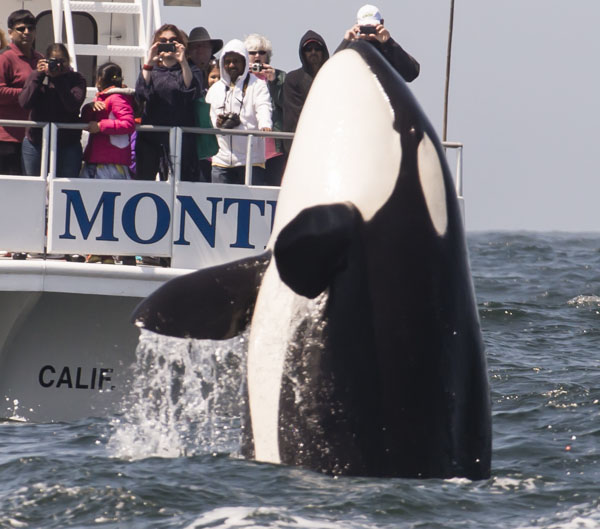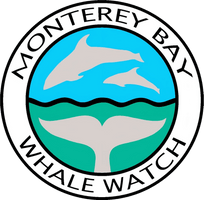ORCAS ATTACK GRAY WHALES IN MONTEREY BAY

Nature’s truth and tragedy unfolded in a dramatic scene on Monterey Bay last week when a pack of 20 orcas attacked a mother gray whale and its calf.
The fight lasted more than two hours, witnessed and photographed by field scout Bart Selby, and dozens aboard whale watching boats that cruised at top speeds to the periphery of the scene and cut their engines. In the past year, Monterey Bay has become the richest marine region on the Pacific Coast.
In the past three weeks, it has reached a new peak with unbelievable hordes of anchovies, along with other baitfish, and with it, the highest numbers of salmon, marine birds, sea lions, gray whales, humpback whales and orcas anywhere.
The bay ignited with life again in early April after the howling winds out of the north in late March set off upwelling in the underwater canyon and jump-started the marine food chain.
At deepwater marine ledges, such as the Continental Shelf west of the Bay Area coast and the Monterey Underwater Canyon, strong north winds will push surface waters to the side, which allows cold, nutrient-rich water to rise up from the depths to the shallows. When sunlight penetrates that nutrient-rich water, it triggers plankton growth, and in turn, the building blocks of the marine food chain.
Monterey’s marine paradise
Although the salmon forecast for the coming year is excellent in many areas on the Pacific Coast, best offshore southern Washington and San Francisco, it is Monterey Bay that has had the fish, the best catches, and on top of it, spectacular sightings of whales and other marine wildlife.
“The biomass of anchovies out there, just billions of tons of feed, is incredible,” said Todd Arcoleo at Chris’s Fishing Trips in Monterey. “It’s brought in the salmon, humpback whales, sea lions, orcas. It’s incredible, just an incredible year.”
A week ago Monday, the humpbacks and killer whales arrived. Tony Lorenz on the Sea Wolf sent me an alert, that he saw 50 humpback whales between Point Joe and Point Lobos.
“Six were real friendly, and swam right up to us,” Lorenz said. “For a prolonged period, we saw them breaching, lunge feeding, pec slapping and plenty of tail throws.”
A school of Pacific white-sided dolphin, numbering over a thousand, has also been sighted, Lorenz and others reported.
Selby, a kayaker, wildlife expert and photographer, heard about the whales and headed straight to Monterey. In 2011, Selby paddled a kayak solo 25 miles from Santa Cruz to Monterey, and two weeks ago, reported sighting a mother gray whale and its calf lounging on the inshore waters at Whaler’s Cove at Pigeon Point near Pescadero.
Selby boarded the Point Sur Clipper with Monterey’s champion whale specialist, Nancy Black, and they quickly found the orcas, more than 20 in all, on the hunt.
Orcas find gray whales
At mid-afternoon, the orcas found a mother gray whale with a calf.
“They came in waves, like attacking swarms of hockey players,” Selby said. “When one group got tired, then the entire line would rotate out and orbit the center ring while a new swarm of orcas pressed the attack.”
Just as a pack of coyotes will try to separate a fawn from its protective mother, the orcas tried to pry the calf away from its mother as well.
“The fight lasted over two hours,” Selby said. “The orcas came in in groups of four or five and tried to separate the whales and drown the baby. They would pulse forward in an attacking line four or five abreast and dive under and on top of the whales.
“The mother fought valiantly. The whales rolled and flailed at their assailants.
“The calf tried to stay on the back of her mom, hooking her tail over mom’s spine, tucking in her flipper so the orcas could not grab them, and even draping her body on top of mom,” Selby said. “Mom fought and fought. We could just see the baby on top of her, often out of the water. The orcas tried to swim between them and dove under and rushed to the surface, pummeling her from below.”
It took a series of prolonged assaults, coming in wave after wave, but they finally succeeded.
With the calf pushed to the side of its mother, the orcas then dragged the baby whale below the surface and drowned it, Selby said.
“I’ve been around enough to know that nature is cruel, but it was hard to watch,” he said.
A feeding spectacle
The orcas then took turns feeding, where they dove down in small groups to take their turns.
All the while, the orcas put on a show where they breached, tail slapped. “It was like they were celebrating their victory,” Selby said.
The mother gray whale abandoned the area quickly. Four big humpbacks showed up to see what was going on, Selby said, and were then harassed by the orcas. Hundreds of gulls and a half-dozen albatross grabbed the leftovers that floated to the surface.
As dusk arrived, the boats returned to port, and by the time they reached land, word had already circulated up and down the coast of the spectacle.
In the past few days, Lorenz reported another attack, where the orcas dragged a carcass of a baby whale around for hours, and then when a sea lion showed up to see what was going on, it got nailed, too.
Sighting killer whales in Monterey Bay is likely through May, he said.
Tom Stienstra is The San Francisco Chronicle’s outdoors writer.
